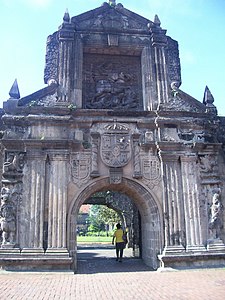Intramuros (Spanish for "within the walls") is the 0.67 square kilometres (0.26 sq mi) historic walled area within the modern city of Manila, the capital of the Philippines. It is administered by the Intramuros Administration (IA) with the help of the Local Government of Manila. IA was created through the Presidential Decree No. 1616 signed on April 10, 1979.[2] IA is tasked to rebuild, redevelop, administer and preserve the remaining pre-war buildings, structures and fortifications of Intramuros.
Intramuros is also called the Walled City, and at the time of the Spanish Empire was synonymous to the City of Manila. Other towns and arrabales (suburbs) located beyond the walls are referred to as "extramuros", the Spanish for "outside the walls".[3][4] It was the seat of government and political power when the Philippines was a component realm of the Spanish Empire. It was also the center of religion, education and economy. The standard way of life in Intramuros became the standard way of life throughout the Philippines. The Manila Galleons which sailed the Pacific for 250 years, carried goods to and from Intramuros (Manila) and Acapulco, Mexico.
Construction of the defensive walls was started by the Spanish imperial government in the late 16th century to protect the city from foreign invasions. The Walled City was originally located along the shores of the Manila Bay, south of the entrance to Pasig River. Guarding the old city is Fort Santiago, its citadel located at the mouth of the river. Land reclamations during the early 20th century subsequently obscured the walls and fort from the bay. The Battle of Manila in 1945 devastated Intramuros. It is the place where the occupying Japanese Imperial Army made their last stand against Allied soldiers and Filipino guerrillas. The battle destroyed its churches, universities, houses, and government buildings, most of which dated back to the Spanish Colonial Period.
Intramuros, particularly the Fort Santiago, was designated as a National Historical Landmark in 1951. The fortifications of Intramuros, collectively called "Fortifications of Manila", were declared as National Cultural Treasures, by the National Museum of the Philippines, owing to its architectural, scientific and archaeological significance.[5] San Agustin Church, a UNESCO World Heritage Site under the Baroque Churches of the Philippines, is located within Intramuros.
Hello My Dear Great Ones,
Last weekend Celia and I went to Manila for a wedding, but before the big event I had a chance to visit Intramuros with some inlaws. It was very interesting time:
Manila Cathedral
We took a horse drawn carriage for a little tour.
San Augustin Church
The door of love.
Inside was quite spectacular.
Large music sheets for church members hundreds of years ago.
Later we went to a Spanish style dwelling.
A bamboo bicycle.
Local scenes:
A very interesting place.
Love adios and ping on!
Dirk

































No comments:
Post a Comment
Note: Only a member of this blog may post a comment.